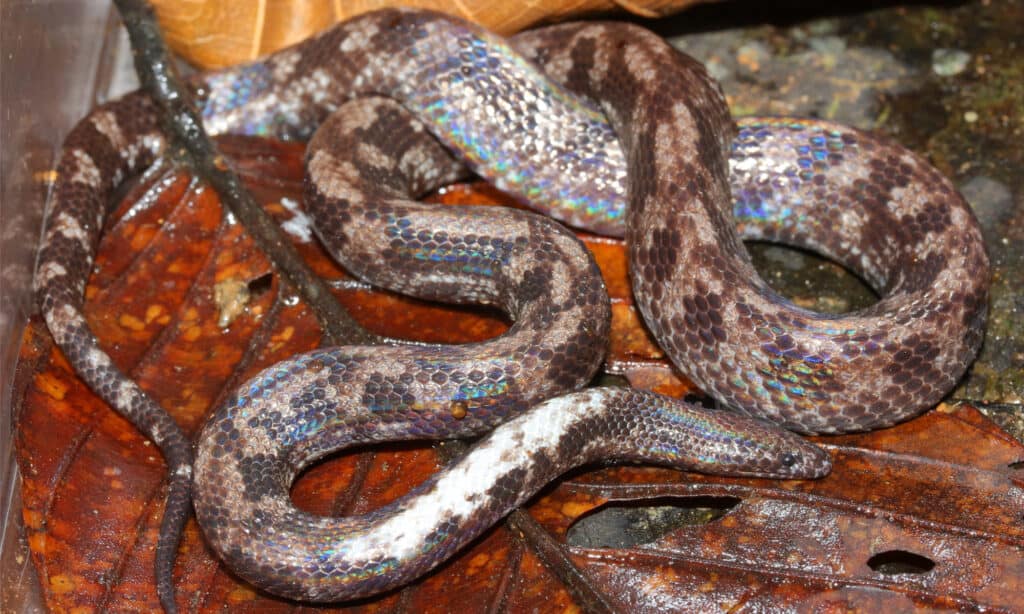Sunbeam Snake
Xenopeltis unicolor
Sunbeam snakes have two lungs instead of just a single lung like most snake species.
Advertisement
Sunbeam Snake Scientific Classification
- Kingdom
- Animalia
- Phylum
- Chordata
- Class
- Reptilia
- Order
- Squamata
- Family
- Xenopeltidae
- Genus
- Xenopeltiis
- Scientific Name
- Xenopeltis unicolor
Read our Complete Guide to Classification of Animals.
Sunbeam Snake Conservation Status
Sunbeam Snake Facts
- Fun Fact
- Sunbeam snakes have two lungs instead of just a single lung like most snake species.
- Diet for this Fish
- Carnivore
- Lifestyle
- Nocturnal
- Favorite Food
- Small birds, reptiles, amphibians and mammals
- Common Name
- Sunbeam snake, common sunbeam snake, iridescent earth snake
- Number Of Species
- 2
Sunbeam Snake Physical Characteristics
- Venomous
- No
- Aggression
- Low
View all of the Sunbeam Snake images!
The Sunbeam snake is one of two species of iridescent-scaled, non-venomous, nocturnal snake found in Southeast Asia.
Their scales in the shade can look brown, pink, or purplish, but in the light, the dark gray, black, or brown scales flash with intense, metallic color. They are occasionally kept as pets because they are relatively docile and require only a small tank size. Sunbeam snakes are one of the oldest living reptile species and have a skeletal structure that differs significantly from newer species.

Six Amazing Facts
- Sunbeam snakes are nocturnal.
- Unlike most other snakes, sunbeam snakes enjoy the dampness.
- Sunbeam snakes have two lungs instead of just a single lung, like most snake species.
- Sunbeam snakes like to burrow in the mud.
- An albino sunbeam snake appears pink instead of black.
- Sunbeam snakes are a type of constrictor, meaning they kill their prey by squeezing it.
Where To Find Them

Sunbeam snakes are iridescent and beautiful.
©MP cz/Shutterstock.com
The sunbeam snake is endemic to Southeast Asia and Indonesia. Its cousin, xenopeltis hainanensis is found in China and Vietnam. They enjoy moist terrain with lots of damp vegetation and mud in which to burrow until nightfall, so they can often be found burrowing in the muck or under leaves. They are found in forests and lower mountain forests with damp ground vegetation, swampy scrublands, rice paddies, and lowland river valleys.
Scientific Name

In certain light, sunbeam snakes’ scales have an iridescent rainbow glow.
©iStock.com/Zdenek Macat
The sunbeam snake comes from the family xenopeltidae and, like all snakes, is in the class reptilia. There are three species of sunbeam snake recognized, including the sunbeam snake, sometimes known as the iridescent ground snake. The scientific names for the three species of sunbeam snakes are xenopeltis unicolor, which is the more common sunbeam snake discussed here in this article, and xenopeltis hainanensis and xenopeltis intermedius. There are only a few small differences between them, mainly with regard to body length and tail size. Xenopeltis is a Greek word meaning small shield, while unicolor means “of one color” in English.
History and Evolution

Sunbeam snakes have been on earth for over 100 million years.
©iStock.com/Zdenek Macat
The earliest known ancestor of snakes was a nighttime hunter that possessed small hindlegs with ankles and toes. Researchers analyzed fossils, genetics, and anatomy of 73 snakes and lizards and concluded that snakes originated on land, not in the ocean, which adds to an ongoing discussion. It is believed that these creatures developed in the warm, woody climates of the Southern Hemisphere about 128 million years ago. Snakes have an astonishing variety, with over 3,400 living species living in diverse habitats such as on land, in water, and in trees. However, there is limited information about where and when they evolved from and what their original ancestor was like in terms of behavior and appearance.
For years, the source of snakes has been a subject of ongoing discussion. Recently, though, researchers have examined this issue in greater detail using cutting-edge methods. By looking at the genes, fossils, and anatomy of 73 species of snakes and lizards (both living and extinct), they were able to gain a better sense of what the initial snake was like. By pinpointing similarities and differences across species, they formulated a large family tree and drew attention to the important traits that have been evident across snake evolution. The data implies that snakes originated on land rather than in water during the middle Early Cretaceous period (around 128.5 million years ago) located in Laurasia. This period corresponds with the emergence of various species of birds and mammals on Earth.
It is believed that the original snake had two small hind legs and preyed on larger animals than lizards of the time. It was not able to coil around larger creatures like modern boa constrictors can. The snake was thought to be active at night, but 50-45 million years ago, this changed when the Colubroidea family of snakes emerged, and they mostly operate during the day. This may have been advantageous due to cooler night temperatures limiting nighttime activity, contributing to their success.
Research indicates that snakes have been able to survive and thrive in many different kinds of habitats thanks to their exceptional capacity for dispersing over long distances. Scientists have estimated that snakes can travel up to 42,500 square miles, which is approximately 4.5 times farther than lizards. Furthermore, they have managed to inhabit environments that are typically impassable for terrestrial animals and have managed to colonize aquatic habitats multiple times throughout their evolution.
Population & Conservation Status

The eyes of a sunbeam snake are small relative to the size of its wedge-shaped heads.
©iStock.com/reptiles4all
The sunbeam snake is listed as being of Least Concern (LC) by the ICUN Red list. They are capable of laying between three and 18 eggs at a time, and their habitat is plentiful for now. Since they like to burrow and only come out at night to hunt, encounters with humans in the wild are lower than many snakes, and they have few natural predators. As of their last assessment back in 2012, their population was listed as stable. Their prevalence is listed as “very common.”
Appearance and Description

Sunbeam snakes can reach 3.5 feet in length.
©iStock.com/dwi septiyana
An adult sunbeam snake is approximately three to three and a half feet in length. They are slender and weigh around two and a quarter pounds when fully grown. Their scales are a dark and shiny gunmetal gray, black, or dark brown, with an iridescent holographic finish. In the shadows, the snakes may appear dark pink or purple. When light hits the scales of a sunbeam snake, the scales appear to be painted with metallic rainbow halos, similar to the colored surface found on an oily puddle on the pavement or the colored swirls on a child’s soap bubbles. These rainbow halos may show any color of the rainbow, though purple and orange may be harder to pick out. Their eyes are small in size compared to their wedge-shaped head and are black or gray in color. Albino sunbeam snakes may be pink or white.
How Dangerous Are They?
Sunbeam snakes are not venomous, and therefore, they pose virtually no threat to humans whatsoever. The three species of sunbeam snake are rarely, if ever, aggressive, except in very specific circumstances when they feel threatened. Sunbeam snakes almost never bite humans, except in the aforementioned situations, such as rough or excessive handling or when accidentally stepped on. These snakes kill their prey by constriction, though they will use their bite to catch it. If these snakes do bite, there is no venom, but a sunbeam snake bite should be treated like any other puncture wound to protect against infection. Consult a physician if you are bitten, just in case a tetanus shot is warranted.
Behavior and Humans
Sunbeam snakes are not venomous and are very docile. These things, combined with their beauty, make them popular pets. However, their intolerance of more than occasional, careful handling and preference for a live diet makes them harder to maintain as pets for inexperienced snake owners, so they are not a pet for beginners or young children. Sunbeam snakes aren’t very large, only three feet long or so, so their enclosure doesn’t need to be very large, either. Having a tank size of about 40 gallons is usually sufficient for up to two sunbeam snakes. The price for a pet sunbeam snake is also reasonable, at around $70 to $100. A pet sunbeam snake that is cared for well can have a lifespan of as long as ten years or more.
3 Species of Sunbeam Snake
All three types of sunbeam snakes are non-venomous and famous for their iridescent scales and quick reproduction.
- Xenopeltis hainanensis lives in China and Vietnam.
- Xenopeltis intermedius lives in Vietnam
- Xenopeltis unicolor lives in Southeast Asia and Indonesia.
Sunbeam Snake FAQs (Frequently Asked Questions)
Can you have a sunbeam snake as a pet?
Yes, a sunbeam snake can be kept as a pet, though prior snake experience is recommended.
What tank size does a sunbeam snake need?
A 40-gallon tank is usually a large enough enclosure for a sunbeam snake.
Is a sunbeam snake poisonous?
Sunbeam snakes are a type of non-venomous snake, so their bite is not dangerous.
Are sunbeam snakes good for beginners?
Though they are docile and small in size, sunbeam snakes are not a particularly good breed for beginners, as they are prone to stress when handled and require live prey for their diet.
Do sunbeam snakes like to be held?
Sunbeam snakes are fairly docile and may not mind being held occasionally, but they may dislike being handled often or for long and emit a musky odor if it stresses them out.
How much does a sunbeam snake cost?
Typically, you may purchase a sunbeam snake for a price between $75 – 100. An albino may have a different price.
Thank you for reading! Have some feedback for us? Contact the AZ Animals editorial team.
Sources
- Everything Reptiles Sunbeam Snake / Accessed May 3, 2022
- Wikipedia / Accessed May 3, 2022
- Ecology Asia / Accessed May 3, 2022
- Thai National Parks / Accessed May 3, 2022
- Reptile Direct / Accessed May 3, 2022
- Outback Reptiles / Accessed May 3, 2022
- Reptile Guide / Accessed May 3, 2022
- Happy Serpent / Accessed May 3, 2022
- Britannica / Accessed May 3, 2022
- Encyclopedia.com / Accessed May 3, 2022
- Animals J Rank / Accessed May 3, 2022
- Nature Nibble / Accessed May 3, 2022
- Reptiles Magazine / Accessed May 3, 2022


















